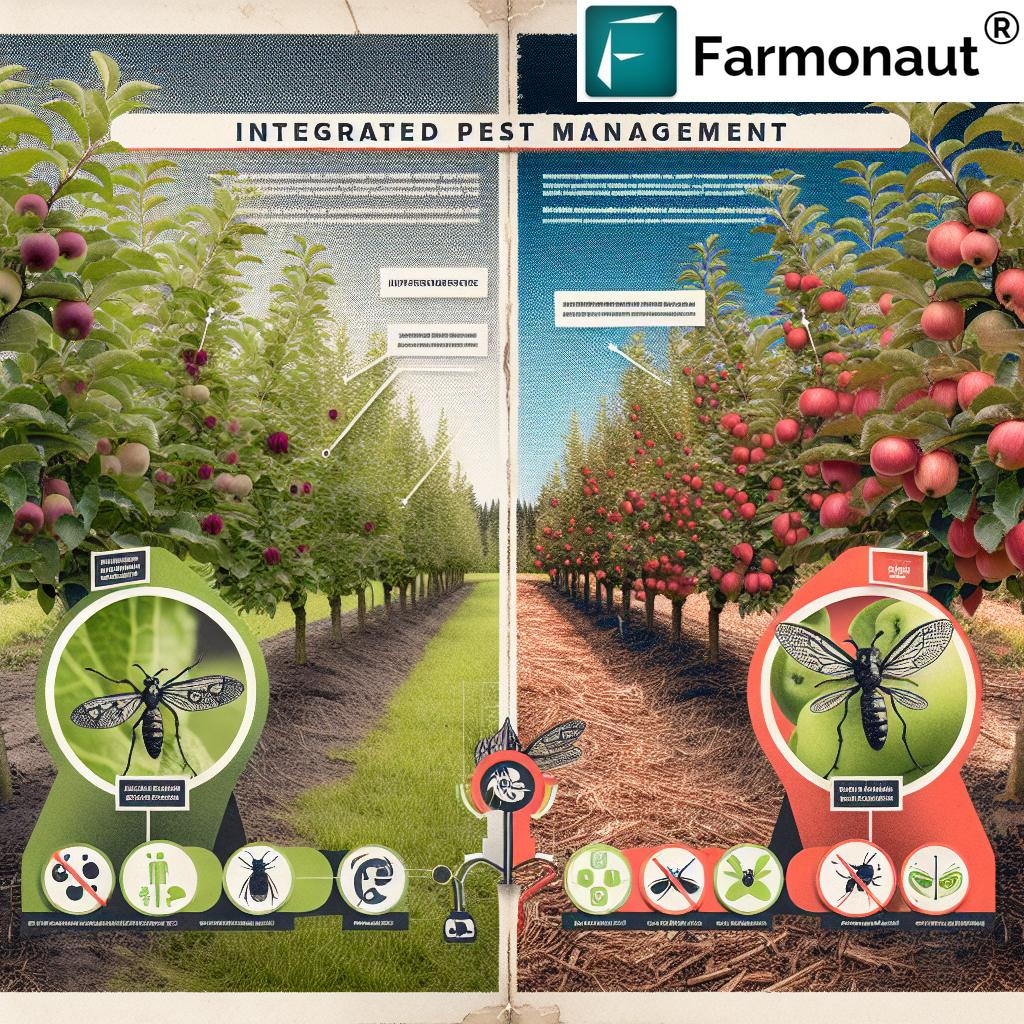Essential Farm Safety: The Ultimate Guide to PPE for Canadian Agricultural Workers
“Over 85% of farm-related injuries can be prevented by proper use of personal protective equipment (PPE).”
Welcome to our comprehensive guide on farm safety and personal protective equipment (PPE) for Canadian agricultural workers. As advocates for sustainable and safe farming practices, we at Farmonaut understand the crucial role that proper safety measures play in modern agriculture. In this blog post, we’ll explore the importance of PPE in mitigating farming hazards and promoting a healthy workplace environment.

As we delve into this essential topic, we’ll cover various aspects of farm safety, from high-visibility clothing to hearing protection and appropriate footwear. Our goal is to provide you with valuable insights that will help you create a more secure and sustainable working environment on your farm.
The Importance of PPE in Canadian Agriculture
Personal protective equipment is the cornerstone of farm safety. In Canada’s diverse agricultural landscape, PPE plays a vital role in safeguarding workers from various hazards associated with farming activities. From handling chemicals to operating heavy machinery, the right protective gear can make all the difference in preventing accidents and ensuring long-term health.
- Reduces risk of injury and occupational diseases
- Enhances worker confidence and productivity
- Promotes a culture of safety on the farm
- Helps comply with Canadian safety regulations
By embracing modern farm safety practices and equipping workers with appropriate PPE, we can significantly reduce the risks associated with agricultural work. This not only protects the health and well-being of farm workers but also contributes to the overall sustainability of the farming industry in Canada.
Essential PPE for Canadian Agricultural Workers
Let’s explore the key components of personal protective equipment that every Canadian farm worker should have access to:
1. High-Visibility Clothing
In the busy environment of a farm, being seen is crucial for safety. High-visibility clothing helps prevent accidents, especially when working around vehicles or in low-light conditions.
- Reflective vests: Essential for early morning or late evening work
- Bright-colored shirts and jackets: Increase visibility during daylight hours
- Reflective strips on work wear: Enhance visibility from all angles
2. Hearing Protection
Farm machinery can produce noise levels that are harmful to hearing. Proper hearing protection is essential for preserving long-term auditory health.
- Earplugs: Ideal for intermittent noise exposure
- Earmuffs: Provide more comprehensive protection for prolonged exposure
- Custom-molded earplugs: Offer a perfect fit for maximum protection
3. Respiratory Protection
Agricultural work often involves exposure to dust, chemicals, and other airborne particles. Proper respiratory protection is crucial for preventing respiratory issues.
- Dust masks: Essential for grain handling and other dusty environments
- Respirators: Necessary when working with chemicals or pesticides
- Filtered face masks: Provide protection against fine particles and organic vapors
4. Eye Protection
Protecting your eyes from debris, chemicals, and UV radiation is crucial in agricultural settings.
- Safety glasses: For general protection against flying debris
- Goggles: Offer full eye coverage, ideal for chemical handling
- Face shields: Provide comprehensive face and eye protection
5. Hand Protection
Hands are constantly exposed to various hazards on the farm. Different types of gloves are needed for different tasks.
- Chemical-resistant gloves: For handling pesticides and fertilizers
- Cut-resistant gloves: For working with sharp tools or barbed wire
- Thermal gloves: For protection in cold weather conditions
6. Foot Protection
Proper footwear is essential for preventing slips, trips, and falls, as well as protecting against falling objects and chemical spills.
- Steel-toed boots: Protect against heavy falling objects
- Slip-resistant soles: Essential for working on wet or slippery surfaces
- Chemical-resistant boots: Necessary when working with hazardous substances
7. Head Protection
Head injuries can be particularly severe, making proper head protection crucial in many farm activities.
- Hard hats: Essential when working around falling objects or in construction areas
- Bump caps: Provide protection in confined spaces
- Sun hats: Offer protection against UV radiation during outdoor work
“Canadian farmers who consistently use appropriate PPE reduce their risk of occupational hearing loss by up to 70%.”
Implementing Effective PPE Strategies on Your Farm
Now that we’ve covered the essential PPE items, let’s discuss how to implement an effective PPE strategy on your farm:
- Conduct a thorough risk assessment: Identify all potential hazards on your farm
- Select appropriate PPE: Choose equipment that addresses specific risks and meets safety standards
- Provide proper training: Ensure all workers know how to use and maintain their PPE
- Establish clear PPE policies: Create and enforce rules for when and where PPE must be worn
- Regularly inspect and replace PPE: Maintain equipment effectiveness through routine checks
- Lead by example: Farm owners and managers should always use PPE when required
By following these steps, you can create a culture of safety on your farm that protects workers and promotes sustainable agricultural practices.

The Role of Technology in Farm Safety
While personal protective equipment forms the foundation of farm safety, modern technology can play a significant role in enhancing overall farm safety practices. At Farmonaut, we believe in leveraging cutting-edge technology to support sustainable and safe farming practices.
Our satellite-based farm management solutions provide valuable insights that can contribute to a safer working environment:
- Real-time crop health monitoring: Reduces the need for frequent physical inspections in potentially hazardous areas
- AI-based advisory systems: Offer recommendations that can help minimize exposure to harmful chemicals or dangerous conditions
- Resource management tools: Optimize the use of machinery and equipment, potentially reducing accident risks
By integrating these technological solutions with proper PPE use, Canadian farmers can create a comprehensive safety strategy that protects workers while improving overall farm efficiency.
Explore Farmonaut’s innovative solutions:
PPE for Specific Agricultural Tasks
Different farming activities require specific types of PPE. Let’s break down some common tasks and the protective equipment needed:
1. Chemical Handling and Application
- Chemical-resistant gloves
- Respirator or filtered face mask
- Chemical-resistant coveralls
- Goggles or face shield
- Chemical-resistant boots
2. Operating Farm Machinery
- Hearing protection (earplugs or earmuffs)
- Safety glasses
- Steel-toed boots
- Close-fitting clothing to avoid entanglement
3. Grain Handling
- Dust mask or respirator
- Safety glasses
- Gloves
- Hearing protection if working around noisy equipment
4. Livestock Handling
- Steel-toed boots
- Heavy-duty gloves
- Protective eyewear
- Long sleeves and pants
5. Working at Heights (e.g., Silo Maintenance)
- Fall protection harness
- Hard hat
- Non-slip footwear
- Safety glasses
By ensuring workers have access to and properly use the right PPE for each task, we can significantly reduce the risk of accidents and injuries on Canadian farms.
Overcoming Barriers to PPE Use
Despite the clear benefits of personal protective equipment, some farmers and agricultural workers may be reluctant to use it consistently. Let’s address some common barriers and how to overcome them:
1. Comfort and Fit
Issue: PPE that doesn’t fit well or is uncomfortable can discourage regular use.
Solution: Invest in high-quality, adjustable PPE and allow workers to try different options to find the most comfortable fit.
2. Cost Concerns
Issue: Some farmers may view PPE as an unnecessary expense.
Solution: Emphasize the long-term cost savings of preventing injuries and illnesses. Consider it an investment in worker health and farm sustainability.
3. Lack of Awareness
Issue: Workers may not fully understand the risks or the importance of PPE.
Solution: Provide comprehensive training on farm hazards and the role of PPE in prevention. Use real-life examples to illustrate the consequences of not using protective equipment.
4. Cultural Resistance
Issue: Traditional farming practices may not have included PPE use.
Solution: Lead by example and gradually introduce PPE as part of the farm’s safety culture. Highlight success stories from other farms that have embraced PPE.
5. Inconvenience
Issue: Putting on and removing PPE can be seen as time-consuming.
Solution: Create convenient storage areas for PPE and establish routines that make donning and doffing equipment a natural part of the workday.
By addressing these barriers head-on, we can foster a culture of safety that prioritizes the use of personal protective equipment on Canadian farms.
The Impact of Proper PPE Use on Farm Sustainability
When we talk about farm sustainability, we often focus on environmental and economic factors. However, social sustainability, which includes worker health and safety, is equally important. Proper use of PPE contributes to farm sustainability in several ways:
- Reduced healthcare costs: Preventing injuries and illnesses leads to lower medical expenses for both workers and farm owners.
- Increased productivity: Healthy workers are more productive, contributing to the farm’s overall efficiency.
- Improved worker retention: A safe working environment helps attract and retain skilled agricultural workers.
- Enhanced reputation: Farms that prioritize safety are viewed more favorably by consumers and the community.
- Long-term viability: By protecting human resources, farms ensure their ability to operate sustainably for generations to come.
At Farmonaut, we believe that integrating safety practices with innovative farm management solutions is key to achieving true agricultural sustainability. Our platform supports this goal by providing tools that complement PPE use and enhance overall farm safety.
Learn more about our API for developers: Farmonaut API
Access our API developer documentation: API Developer Docs
PPE Checklist for Canadian Agricultural Workers
| Farm Task | Required PPE | Safety Benefits |
|---|---|---|
| Operating Machinery |
– Hearing protection – Safety glasses – Steel-toed boots – Close-fitting clothing |
– Prevents hearing loss – Protects eyes from debris – Guards against foot injuries – Reduces risk of entanglement |
| Handling Chemicals |
– Chemical-resistant gloves – Respirator or face mask – Goggles or face shield – Chemical-resistant coveralls – Chemical-resistant boots |
– Prevents skin exposure to harmful substances – Protects against inhalation of toxic fumes – Guards eyes from chemical splashes – Shields body from chemical contact – Prevents chemical absorption through feet |
| Grain Handling |
– Dust mask or respirator – Safety glasses – Gloves – Hearing protection |
– Prevents inhalation of grain dust – Protects eyes from dust and debris – Guards hands from abrasions – Reduces noise exposure from equipment |
| General Farm Work |
– Sun hat – Long-sleeved shirt – Long pants – Sturdy, closed-toe shoes |
– Protects against UV radiation – Guards against sun exposure and minor scrapes – Shields legs from cuts and abrasions – Prevents foot injuries from various hazards |
Maintaining and Caring for Your PPE
Proper maintenance of personal protective equipment is crucial for ensuring its effectiveness and longevity. Here are some tips for caring for your PPE:
- Regular cleaning: Clean PPE according to manufacturer instructions after each use
- Proper storage: Store PPE in a clean, dry place away from direct sunlight and chemicals
- Routine inspections: Regularly check for signs of wear, tear, or damage
- Timely replacements: Replace PPE that is damaged, worn out, or past its expiration date
- Follow manufacturer guidelines: Adhere to specific care instructions for each type of PPE
By properly maintaining your PPE, you not only extend its life but also ensure it provides maximum protection when you need it most.
The Future of Farm Safety and PPE
As technology continues to advance, we can expect to see innovations in farm safety and personal protective equipment. Some emerging trends include:
- Smart PPE: Incorporating sensors to detect environmental hazards or monitor worker health
- Improved materials: Development of lighter, more comfortable, and more durable PPE materials
- Integration with farm management systems: PPE that communicates with farm monitoring systems for enhanced safety
- Virtual reality training: Immersive safety training experiences to improve PPE use and hazard awareness
- Customized PPE solutions: 3D-printed or tailored PPE for better fit and comfort
At Farmonaut, we’re excited about these advancements and how they can complement our satellite-based farm management solutions to create even safer and more efficient farming practices.
Conclusion: Embracing a Culture of Safety on Canadian Farms
As we’ve explored throughout this guide, personal protective equipment is an essential component of modern farm safety practices. By embracing PPE use and integrating it with innovative farm management solutions, Canadian agricultural workers can significantly reduce their risk of injury and illness while contributing to the long-term sustainability of their farms.
Remember, farm safety is not just about compliance with regulations—it’s about protecting the health and well-being of workers, their families, and the entire farming community. By prioritizing safety and making PPE use a natural part of daily farm operations, we can create a more secure, productive, and sustainable agricultural sector in Canada.
At Farmonaut, we’re committed to supporting Canadian farmers in their efforts to improve farm safety and efficiency. Our satellite-based farm management solutions complement PPE use by providing valuable insights that can help reduce exposure to hazards and optimize farm operations.
We encourage all Canadian farmers and agricultural workers to take a proactive approach to safety. Invest in quality PPE, provide thorough training, and stay informed about the latest safety practices and technologies. Together, we can build a safer and more sustainable future for Canadian agriculture.
FAQ Section
Q: Why is PPE important in agriculture?
A: PPE is crucial in agriculture because it protects workers from various hazards such as chemicals, dust, noise, and machinery-related risks. It helps prevent injuries and long-term health issues, ensuring the safety and well-being of agricultural workers.
Q: How often should I replace my PPE?
A: The frequency of PPE replacement depends on the type of equipment and its usage. Generally, you should replace PPE when it shows signs of wear and tear, damage, or contamination. Always follow manufacturer guidelines for specific replacement schedules.
Q: Can I use the same PPE for different farm tasks?
A: While some PPE items like safety glasses or steel-toed boots might be suitable for multiple tasks, others are task-specific. Always ensure you’re using the appropriate PPE for each specific farm activity to maintain optimal protection.
Q: How can I encourage my farm workers to consistently use PPE?
A: Encourage PPE use by providing proper training, leading by example, making PPE easily accessible, and fostering a culture of safety on your farm. Regularly discuss the importance of PPE and address any concerns or discomfort issues promptly.
Q: Are there any government resources available for farm safety in Canada?
A: Yes, the Canadian Agricultural Safety Association (CASA) provides numerous resources on farm safety, including information on PPE use. Provincial agriculture departments also offer safety guidelines and resources specific to their regions.
















